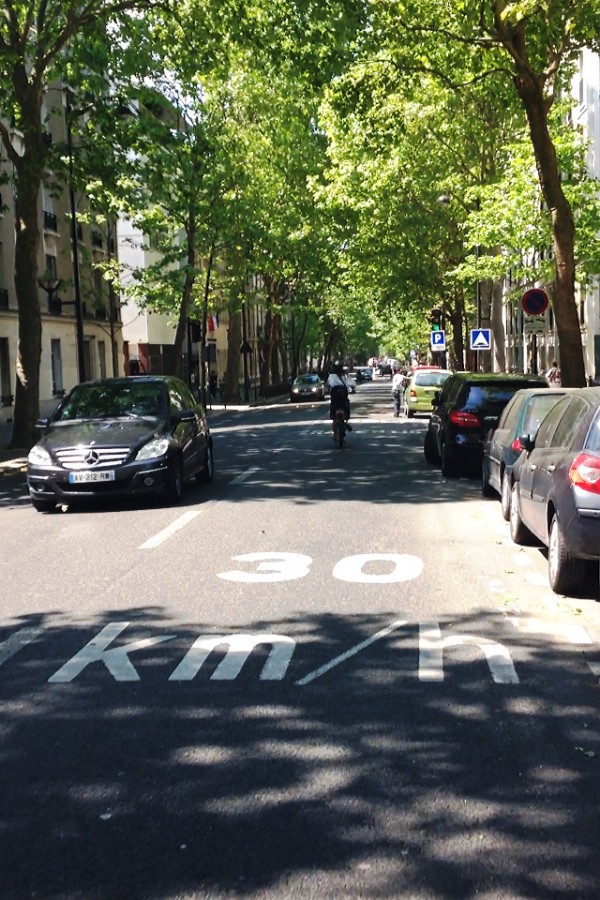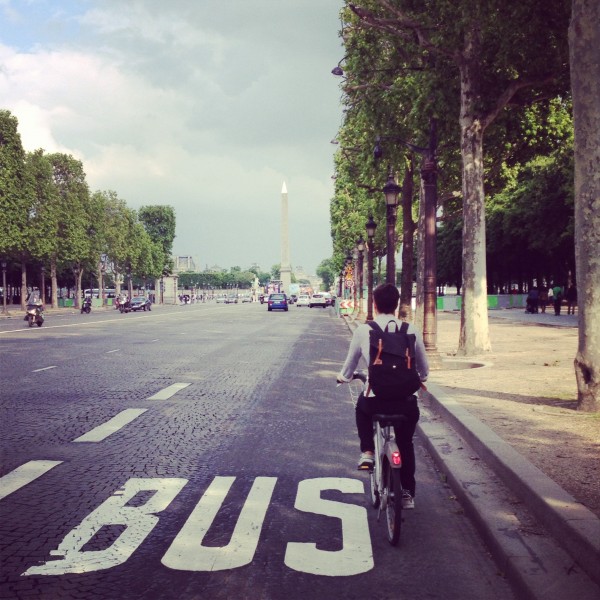This post by Mikey Bennington is part of Spacing‘s partnership with the Toronto Cycling Think and Do Tank at the University of Toronto. Find out more about the think tank, and the series, here.
Riding a bike along Parisian Streets and pathways gives the distinct feeling of being part of la Foule – that great mass of people, anonymous but unified, which mysteriously imparts an egalitarian compass to guide and order the sum of movements throughout the city. For the North American cyclist on French soil, you feel surprisingly liberated by this messy, crowded, but somehow less confrontational approach to transportation.
La Foule (the crowd), and the necessarily winding paths through its masses, perfectly conveys my own experience of visiting a city world renowned for its leadership in cycling thanks to Vélib; its extensive city-wide bike sharing program, and other progressive transportation measures. After 8 wonderful days biking back and forth through the city’s arrondissements, I was left to wonder: how exactly did Paris achieve the feeling of integrated, non-confrontational unity in their daily travel choices. Can my home back across the pond learn something from their situation?
As a cyclist conditioned to extreme vigilance for car-danger, the streets of Paris were a welcome blend of permissiveness mixed with respectful and cautious rule bending. There is a definite flow. Traffic ebbs towards the paths of least resistance, without ever culminating in a waterfall of excessive speeds. For that, I have to thank the traffic calming measures taken by the city. Back in 2010, Paris reduced speeds on many of the narrow circuitous streets in their dense neighborhoods to 30kph.

This enforced pacing creates drastically safer interactions between cars, cyclists and pedestrians. However, pointing only to rule enforcement misses an ironic and important quality of my experience in French traffic. The French have employed these rules, but drivers and cyclist alike are not blindly rule-abiding. Cars will creep slowly, but eagerly towards you, sometimes while breaking a traffic rule. This was initially terrifying, but over my time in Paris I noticed drivers’ actions lacked the malevolence and hostility I had learned to associate with similar actions in North America. Instead, driver’s had a surprising respect for my place as part of traffic.
To North American ears, this echoes the tensions we experience with the rule bending and subsequent finger pointing that exacerbates the identity–led divisiveness in the North American car vs. bike debate. But in Paris the framework of this debate seems all together quite different. The identity politics so typical of North American cyclists and car drivers alike, just doesn’t seem as important here. Cycling is merely something people do. Bikes and cars are much less implicated in personal identity. One interesting explanation I would suggest for this very different presentation of identity is the idea of French singularity (Mona Ozouf); that grand abstract organizing principle that declares France not a nation of sub-divided special interest groups, but as an egalitarian group of individuals unified by French Culture and experience. Perhaps this French essence supersedes sub-group identity, making “us vs. them” frameworks in the transportation debate somehow less legitimate? Whatever the explanation, the absence of adversarial confrontation on its streets is palpable.
As we grow cycling participation in Canadian cities, I think we would be well served to consider Paris as a messy but important stepping-stone on the long-term road to establishing strong Canadian cycling cultures. We so often tout the “grass is greener” ideation of established European cycling cities like Amsterdam and Copenhagen with their longstanding enmeshed cycling cultures. Paris is a degree closer to us. It is still negotiating the integration of different modes of transport, and they have managed to do so while limiting divisiveness and confrontation, even while vying for limited road space. If, despite the odds, we can similarly avoid divisiveness and confrontation, we will be poised to reach our goals for cycling and transportation back home.
Mikey Bennington is a researcher with the Toronto Cycling Think & Do Tank.


4 comments
Eight days is a very short amount of time to understand a foreign culture, and as a result the theories presented in this article seem more the result of fanciful thinking rather than thorough comprehension of what’s happening in Paris.
First, to address the issue of cyclist safety:
It’s worth noting that obtaining a French driver’s licence takes far longer and is more rigorous than in Canada or the USA. People fail their driver’s exams at an astounding rate (I never met anyone who passed it on the first try), but are much better drivers for it at the end. As a rule, the French understand the rules of the road much better and are far more vigilant when driving than North Americans.
Second, anyone who has lived in Paris cannot have failed to notice the enormous number of motorcycles, mopeds, and scooters on the streets (80,000 at last count, a 35% increase since 2001, even as overall traffic has declined), which weave in and out of traffic, drive on the sidewalks, and go the wrong way down one-way streets. As a result, drivers have learned to anticipate their movements and react quickly. And these reflexes aren’t limited to two-wheelers: Parisians are all veteran jay-walkers and cars have to be hyper-aware of the movements of pedestrians when driving, leading to more cautious conduct.
These two factors create a much safer environment for bike riding, both because car drivers are used to sharing the road with others and because they have the skills necessarily to drive safely with and around them.
As far the normality of bike riding, the idea that the French are united by a common culture is more redolent of the graduate school seminar room than reality. Evidently, there are conflicting group identities (witness France’s anti-gay marriage protests last month), including those dealing with transportation. At the occasion of the unveiling of the newly pedestrianized Place de la République on Sunday, Mayor Bertrand Delanoë was accused of being “anti-car” by the right-wing UMP. French identity has never revolved around driving the way American culture has idealized the automobile, but bike-friendliness is a relatively recent development in all European cities—even places like Copenhagen—one that dates from the 1960s. The acceptance of alternative modes of transportation is the result of concerted political action stretching across decades.
Note also that (according to wikipedia) Toronto has an area of 630km^2 while Paris has an area of 105km^2. This means Paris is about 17% the size of Toronto, and has a population density 500% higher. This makes using non-automotive forms of transportation significantly different. Car ownership and usage rates are also much lower.
Cycling-friendlness in contemporary (post WW2) Paris is much, much more recent than in Copenhagen, Amsterdam or even Strasbourg. I cycled in Paris in the 1980s, not in the city centre, but close to the photo of Belleville (northeastern Paris) and it was a rather harrowing experience.
The changes in cyclability and walkability in this beautiful but car-infested city have been momentous. Paris is still far from the cities I cited above in terms of a safe, complete cycling infrastructure, but it has made impressive steps.
Thanks to Mikey for sharing his experience and reflections on cycling in this other metropolis. I wonder how cyclist fatalities compare between Toronto and Paris. I wonder if Parisian cyclists would concur with his sense of relative egalite and bonhomie with motorists.
Thanks to Stephen and other commenters for great informative elaborations. It is a relief to read a comments stream that functions more like collaborative weaving of story-strands, rather than an open sewer of adversarial vitriol.